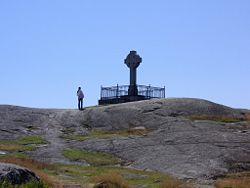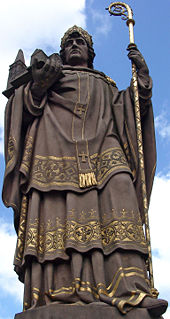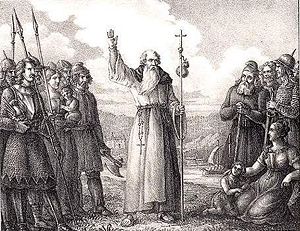Difference between revisions of "Ansgar" - New World Encyclopedia
m |
m (→Lagacy) |
||
| Line 56: | Line 56: | ||
==Lagacy== | ==Lagacy== | ||
[[Image:Birka Ansgar 2008.jpg|thumb|250px|Cross devoted to Saint Ansgar in [[Birka]], [[Sweden]]]] | [[Image:Birka Ansgar 2008.jpg|thumb|250px|Cross devoted to Saint Ansgar in [[Birka]], [[Sweden]]]] | ||
| − | Ansgar's title as "Apostle of the North," was bestowed on him relatively early. It rests not so much on his actual accomplishments as it does on the inspiring example which he set, largely as a result of the tradition preserved in his hagiography. In fact, the missions that he established in Denmark and Sweden were virtually destroyed by later pagan reaction and raids. He is nevertheless recognized as the | + | Ansgar's title as "Apostle of the North," was bestowed on him relatively early. It rests not so much on his actual accomplishments as it does on the inspiring example which he set, largely as a result of the tradition preserved in his hagiography. In fact, the missions that he established in Denmark and Sweden were virtually destroyed by later pagan reaction and raids. He is nevertheless recognized as the founder of Christianity in [[Scandinavia]]. And Episcopal prayer given on his feast day goes as follows: |
| + | |||
| + | <blockquote>Almighty and everlasting [[God]], you sent your servant Anskar as an apostle to the people of Scandinavia, and enabled him to lay a firm foundation for their conversion, though he did not see the results of his labors: Keep your Church from discouragement in the day of small things, knowing that when you have begun a good work you will bring it to a fruitful conclusion... Amen.</blockquote> | ||
Written by his successor [[Rimbert]], the ''[[Vita Ansgari|Vita Ansgarii]]'' preserved the outline of Ansgar's biography and several legends associated with his missionary activities. It also records Ansgar's visions, which encouraged and assisted Ansgar's missionary feats. In Rimbert's account a divine vision precedes each stage of Ansgar's career. For example, his early studies and ensuing devotion to the [[asceticism|ascetic life]] of a [[monk]] were inspired by a vision of his mother in the presence of Virgin Mary. Later, in his travels northward, he was led by a vision to the [[abbot]] [[Adalhard]], who would instruct him in what was to happen. | Written by his successor [[Rimbert]], the ''[[Vita Ansgari|Vita Ansgarii]]'' preserved the outline of Ansgar's biography and several legends associated with his missionary activities. It also records Ansgar's visions, which encouraged and assisted Ansgar's missionary feats. In Rimbert's account a divine vision precedes each stage of Ansgar's career. For example, his early studies and ensuing devotion to the [[asceticism|ascetic life]] of a [[monk]] were inspired by a vision of his mother in the presence of Virgin Mary. Later, in his travels northward, he was led by a vision to the [[abbot]] [[Adalhard]], who would instruct him in what was to happen. | ||
Revision as of 00:29, 25 January 2009
| Saint Ansgar | |
|---|---|
Statue of Ansgar in Bremen | |
| Apostle of the North | |
| Born | September 8 801 in Amiens |
| Died | 3 February 865 (aged 63) in Bremen |
| Venerated in | Eastern Orthodox Church, Roman Catholicism, Lutheran Church, Anglican Church |
| Feast | February 3 |
| Patronage | Denmark |
Saint Ansgar, Anskar or Oscar, (September 8?, 801 – February 3, 865) was an Archbishop of Hamburg-Bremen. The see of Hamburg was designated a "Mission to bring Christianity to the North," and Ansgar became known as the "Apostle of the North."
Life
Ansgar was born in Amiens, France. After his mother’s early death he was brought up in nearby Corbie Abbey, where he made rapid progress in his education. According to the Vita Ansgarii ("Life of Ansgar"), as a young boy received a vision in which he learned that his mother was in the company of the Virgin Mary. As a result, his formerly careless attitude toward spiritual matters quickly changed to one of absolute seriousness.
In 822 Ansgar was one of a number of missionaries sent to found the abbey of Corvey (New Corbie) in Westphalia, and there became a teacher and preacher. Ansgar was a product of the phase of Christianization of Saxony, present day northern Germany which had begun under Charlemagne and continued by his son and successor, Louis the Pious. After Saxony's Christianization was more or less completed, Ansgar and other missionaries looked further north for fresh fields in which to sow the seeds of the Gospel.
When Harald Klak, the newly baptized king of parts of Denmark, returned to his country from exile, Ansgar returned with him. Ebbo, the archbishop of Reims, had previous attempted missionary work there without much success. Angar founded a school at Schleswig in South Jutland, but his missionary activities provoked storm of opposition from the local inhabitants, resulting in the expulsion of Ansgar and other missionaries from the area. Ansgar then returned returned to the Frankish realm.
In 829, Louis I appointed Ansgar missionary to Sweden, in response to a request from the Swedish king Björn at Hauge for a mission to the Swedes. Although the embassy was attacked on its way and was thought to have abandoned its mission, Angar succeeded in entering the country. He was favorably received by the king and given permission to preach. With an assistant, the friar Witmar, he made converts for six months at Birka on Lake Mälaren. They organized a small congregation there, with the king's steward, Hergeir, as its most prominent member. In 831, Ansgar returned to Louis' court at Worms and was appointed to archbishop of Hamburg in 831.
Hamburg was a new archbishopric with the right to send missions into all the northern lands and to consecrate bishops for these territories. After being consecrated in November 831 and receiving the approval of Pope Gregory IV, Ansgar went to Rome to receive the pallium, the symbol of his authority as the pope's representative. He received this symbol of his office directly from the pope, who named him papal legate for the northern lands. This position had previously been bestowed upon Ebbo of Reims, but the jurisdiction was now divided by mutual agreement, with Ebbo retaining Sweden for himself.
For a time Ansgar devoted himself to the needs of his own diocese, which was still missionary territory with only a few churches. He revived the abbey of Turholt in Flanders and established a school there.
After Louis the Pious died in 840, his empire was divided, to Ansgar's disadvantage. As a result, Ansgar lost possession of the abbey of Turholt. Taking advantage of the divided Frankish kingdom, Eric, the king of Danes of Jutland, unexpectedly sent a fleet of 600 ships and sacked Hamburg in 845. The marauding Danes seized or destroyed the treasures and books of Ansgar's churches, and the entire diocese was left in ruins. Moreover, Ansgar was left without a means of collecting revenue to carry out his duties. Ansgar was for some time a fugitive and was also deprived of his Flemish possessions by King Charles the Bald.
Many of Ansgar's assistants deserted him. However, Louis the German came to his aid. After failing to recover Turholt for him, the king awarded him the vacant diocese of Bremen, where Angar took up residence in 848. This, however, aroused the anger of the bishop of Cologne, to whom Bremen had been subject. (Only after prolonged negotiations did Pope Nicholas I finally approve the union of the dioceses of Hamburg and Bremen about a decade later.)
Through the political turmoil of the late 840s, Ansgar continued his mission to the northern lands. During the Danish civil war he established good relations with his former bitter enemy, Horik I (Eric). During this time, he was able to secure the recognition of Christianity as a tolerated religion and established a church in Sleswick. He also influence him to mitigate the horrors of the slave trade, while not eliminating it completely.
Ansgar also devoted his energy to the Swedish mission, spending two years there in person (848-850). This proved to be a critical moment when once again a pagan reaction threatened, which Ansgar succeeded in averting. Ansgar returned again to Sweden during the reign of king Olof in Birka c. 854. This king was well disposed to Christianity, and Ansgar's biographer relates that during a raid against in Courland, the Vikings prayed and received God's help in plundering the the country.
Finally having achieved a measure of success, among the works credited to Ansgar is the introduction of bells in the worship of the northern churches, an innovation that particularly impressed the pagans, who considered them as instruments of magic. He was eminent for his piety, asceticism, and observance of the monastic Rule of Saint Benedict. He built hospitals, ransomed captives, and sent alms abroad. His one expressed regret was that he had not been found worthy of martyrdom.
Ansgar eventually returned to Bremen, where he died in 865.
Lagacy

Ansgar's title as "Apostle of the North," was bestowed on him relatively early. It rests not so much on his actual accomplishments as it does on the inspiring example which he set, largely as a result of the tradition preserved in his hagiography. In fact, the missions that he established in Denmark and Sweden were virtually destroyed by later pagan reaction and raids. He is nevertheless recognized as the founder of Christianity in Scandinavia. And Episcopal prayer given on his feast day goes as follows:
Almighty and everlasting God, you sent your servant Anskar as an apostle to the people of Scandinavia, and enabled him to lay a firm foundation for their conversion, though he did not see the results of his labors: Keep your Church from discouragement in the day of small things, knowing that when you have begun a good work you will bring it to a fruitful conclusion... Amen.
Written by his successor Rimbert, the Vita Ansgarii preserved the outline of Ansgar's biography and several legends associated with his missionary activities. It also records Ansgar's visions, which encouraged and assisted Ansgar's missionary feats. In Rimbert's account a divine vision precedes each stage of Ansgar's career. For example, his early studies and ensuing devotion to the ascetic life of a monk were inspired by a vision of his mother in the presence of Virgin Mary. Later, in his travels northward, he was led by a vision to the abbot Adalhard, who would instruct him in what was to happen.
Statues dedicated Ansgar stand in Hamburg and Copenhagen as well as a stone cross at Birka. A crater on the Moon, Ansgarius, has been named for him. Ansgar is the patron saint of Denmark. He is known in Germany as Saint Scharies. His feast day is February 3.
See also
- Hochkirchlicher Apostolat St. Ansgar
| New creation | Archbishop of Hamburg 834-865 |
Succeeded by: Rimbert |
| Preceded by: Leuderich |
Bishop of Bremen 848-865 |
ReferencesISBN links support NWE through referral fees
- Carver, M. O. H. The Cross Goes North: Processes of Conversion in Northern Europe, AD 300-1300. Woodbridge, Suffolk, UK: York Medieval Press, 2003. ISBN
- Cusack, Carole M. The Rise of Christianity in Northern Europe, 300-1000. Cassell religious studies. London: Cassell, 1999. ISBN 9780304707355
- Tschan, Francis J. History of the Archbishops of Hamburg-Bremen. New York: Columbia University Press, 2002. ISBN 9780231125741
- Wood, Ian. The Missionary Life: Saints and the Evangelisation of Europe, 400 – 1050. New York: Longman, 2001. ISBN 9780582312135
- This article includes content derived from the Schaff-Herzog Encyclopedia of Religious Knowledge, 1914, which is in the public domain.
External links
- Ansgar at Birka History
- Vita Ansgari, English translation from Medieval sourcebook: Life of Ansgar
- German History Forum
Credits
New World Encyclopedia writers and editors rewrote and completed the Wikipedia article in accordance with New World Encyclopedia standards. This article abides by terms of the Creative Commons CC-by-sa 3.0 License (CC-by-sa), which may be used and disseminated with proper attribution. Credit is due under the terms of this license that can reference both the New World Encyclopedia contributors and the selfless volunteer contributors of the Wikimedia Foundation. To cite this article click here for a list of acceptable citing formats.The history of earlier contributions by wikipedians is accessible to researchers here:
The history of this article since it was imported to New World Encyclopedia:
Note: Some restrictions may apply to use of individual images which are separately licensed.

